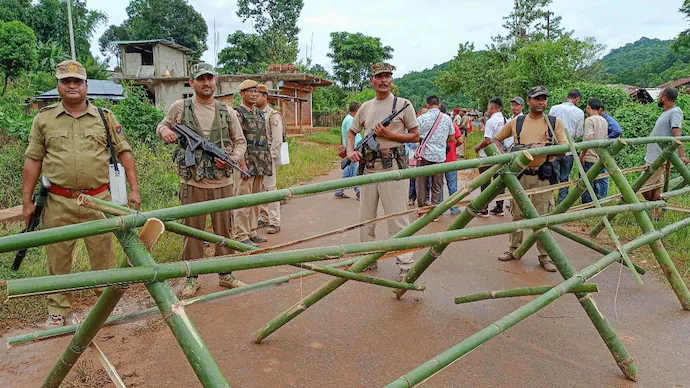News Highlight
Assam-Meghalaya Border Firing flared up the longstanding inter-state boundary dispute in 12 stretches of their 884-km shared boundary.
Key Takeaway
The National Human Rights Commission (NHRC) has requested a response from the centre on preventing border firing.
The Assam-Meghalaya border dispute
- Background
- During British rule, undivided Assam included present-day Nagaland, Arunachal Pradesh, Meghalaya and Mizoram.
- Before 1970, Meghalaya was a part of Assam.
- Meghalaya was carved out of Assam as an autonomous state in 1970 and became a full-fledged state in 1972 as per the Assam Reorganisation (Meghalaya) Act of 1969.
- Assam shares an 884.9 km long border with Meghalaya.
- The border dispute stems from the Meghalaya government’s refusal to accept the Assam Reorganisation (Meghalaya) Act of 1969 leading to a dispute over 12 areas in different parts of the 885-km-long interstate border.
- These 12 disputed areas are Tarabari, Langpih, Borduar, Gijang Reserve Forest, Bokalapara, Hahim, Nongwah, Matmoor, Khanapara-Pilangkata, Deshdemorah Block One, and Block 2, Retchera and Khanduli.
- The attempts to resolve the dispute
- In 1985, under then Assam chief minister Hiteswar Saikia and Meghalaya chief minister Captain W A Sangma, an official committee was constituted under the former Chief Justice of India Y V Chandrachud.
- However, no solution was discovered.
- In 2011, Meghalaya Assembly passed a resolution for the intervention of the centre and the establishment of a boundary commission.
- On January 29 this year, Assam and Meghalaya signed a draft resolution. It was the first step towards resolving a 50-year-old dispute.
- On March 29, a historic MoU (Memorandum of Understanding) was signed between Assam Chief Minister Himanta Biswa Sarma and his Meghalaya counterpart Conrad K Sangma in the presence of Home Minister Amit Shah in New Delhi.
- The agreement sought closure in six disputed sectors that were taken up for resolution in the first phase.
- The six disputed sectors were Tarabari, Gizang, Hahim, Boklapara, Khanapara-Pilangkata and Ratacherra under the Kamrup, Kamrup, and Cachar districts of Assam and the West Khasi Hills, Ri-Bhoi and East Jaintia Hills districts of Meghalaya.
- On August 22 this year, the second phase of border talks was held with the two states deciding to form three regional committees to resolve issues regarding the remaining six disputed areas.
- Five principles considered while resolving the border issues
- Historical facts
- Ethnicity
- Administrative Convenience
- Willingness and sentiments of the people concerned and the contiguity of the land
- Preferably with natural boundaries such as rivers, streams, and rocks
How can inter-state border disputes be resolved?
- It can be resolved by the states themselves or by the Center through dialogue and political settlements.
- Disputes can also be settled by the Supreme Court.
The National Human Rights Commission (NHRC)
- The National Human Rights Commission, or NHRC, is an independent body of the Government of India tasked with promoting and protecting human rights.
- It is a statutory body mentioned in the Indian Constitution that was established in 1993 under the ‘Protection of Human Rights Act.‘
Conclusion
- Resolving a long-standing border dispute is a must for a peaceful and prosperous northeastern state. Furthermore, as a focal point of India’s Act East Policy, the northeastern state has enormous potential for tourism, agriculture, sports, and so on. Therefore, it is necessary to resolve pending issues, border conflicts, and insurgencies; however, in doing so, it is crucial to prioritize the needs and ambitions of the local population.
Pic Courtesy: India Today
Content Source: Indian Express



